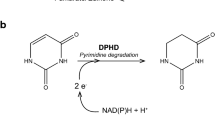Abstract
Deletion mutants for the yeast transketolase gene TKL1 were constructed by gene replacement. Transketolase activity was below the level of detection in mutant crude extracts. Transketolase protein could be detected as a single protein band of the expected size by Western-blot analysis in wild-type strains but not in the delection mutant. Deletion of TKL1 led to a reduced but distinct growth in synthetic medium without an aromatic amino-acid supplement. We also isolated double and triple mutants for transketolase (tkl1), transaldolase (tal1), and glucose 6-phosphate dehydrogenase (zwf1) by crossing the different mutants. A tal1 tkl1 double mutant grew nearly like wild-type in rich medium. Only the tkl1 zwf1 double and the tal1 tkl1 zwf1 triple mutant grew more slowly than the wild-type in rich medium. This growth defect could be partly alleviated by the addition of xylulose but not ribose. The triple mutant still grew slowly on a synthetic mineral salts medium without a supplement of aromatic amino acids. This suggests the existence of an alternative but limited source of pentose phosphates and erythrose 4-phosphate in the tkl1 zwf1 double mutants. Hybridization with low stringency showed the existence of a sequence with homology to transketolase, possibly a second gene.
Similar content being viewed by others
References
Broach JR (1983) Methods Enzymol 101:307–325
Burnette WN (1981) Anal Biochem 112:195–203
Ciriacy M, Breitenbach I (1979) J Bacteriol 139:152–160
Datta AG, Racker E (1961) J Biol Chem 136:617–623
Fletcher TS, Kwee IL, Nakada T, Largman C, Martin BM (1992) Biochemistry 31:1892–1896
Ho NWY, Chang SF (1989) Enzyme Microb Technol 11:417–421
Horecker BL, Mehler AH (1955) Annu Rev Biochem 24:207–274
Horecker BL, Gibbs M, Klenow H, Smyrniotis PZ (1954) J Biol Chem 207:393–403
Josephson BJ, Fraenkel DG (1974) J Bacteriol 118:1082–1089
Laemmli UK (1970) Nature 227:680–685
Nogae I, Johnston M (1990) Gene 96:161–169
Sambrook J, Fritsch EF, Maniatis T (1989) Molecular cloning: a laboratory manual. Cold Spring Harbor Laboratory, Cold Spring Harbor, New York
Schaaff I, Hohmann S, Zimmermann FK (1990) Eur J Biochem 188:597–603
Schiestl RH, Gietz D (1989) Curr Genet 16:339–346
Thomas D, Cherest H, Surdin-Kerjan Y (1991) EMBO J 10:547–553
Yanisch-Perron C, Vieira J, Messing J (1985) Gene 33:103–119
Zamenhoff S (1957) Methods Enzymol 3:696–704
Author information
Authors and Affiliations
Additional information
Communicated by K. Wolf
Rights and permissions
About this article
Cite this article
Schaaff-Gerstenschläger, I., Zimmermann, F.K. Pentose-phosphate pathway in Saccharomyces cerevisiae: analysis of deletion mutants for transketolase, transaldolase, and glucose 6-phosphate dehydrogenase. Curr Genet 24, 373–376 (1993). https://doi.org/10.1007/BF00351843
Received:
Accepted:
Issue Date:
DOI: https://doi.org/10.1007/BF00351843



